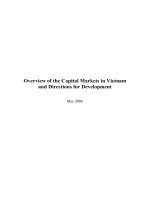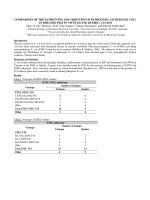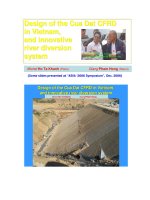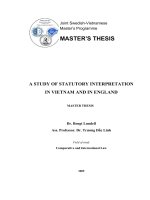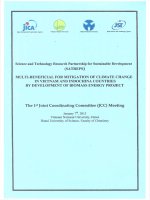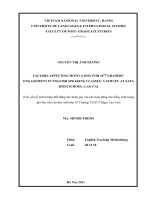Educational mottos of tertiary institutions in Vietnam and English speaking countries: A study of syntactic features - TRƯỜNG CÁN BỘ QUẢN LÝ GIÁO DỤC THÀNH PHỐ HỒ CHÍ MINH
Bạn đang xem bản rút gọn của tài liệu. Xem và tải ngay bản đầy đủ của tài liệu tại đây (422.3 KB, 7 trang )
<span class='text_page_counter'>(1)</span><div class='page_container' data-page=1>
<b>EDUCATIONAL MOTTOS OF TERTIARY INSTITUTIONS </b>
<b>IN VIETNAM AND ENGLISH-SPEAKING COUNTRIES: </b>
<b>A STUDY OF SYNTACTIC FEATURES </b>
<b>Nguyen Thi Bich Phuong*</b>
University of Languages and International Studies, Vietnam National University, Hanoi
<i>Received: 01/08/2019; Revised: 18/09/2019; Accepted: 25/12/2019 </i>
<b>Abstract: </b>It should be noted that at present educational sector has clearly shown its worth in accordance
with the development of human society. The fact remains that numerous Vietnamese universities and
colleges have penetrated into overseas educational sector, receiving thousands of foreign students
annually and adopting various advertising campaigns using a wide range of English mottos. It is
inevitable that those universities and colleges may make some mistakes when creating fitting mottos for
their vision and mission. On the basis of the analyzed results, the study is expected to give an in-depth
insight in one of the most integral aspects of linguistic characteristics of educational mottos, syntax,
which centers on investigating the way structural components are arranged. Furthermore, similarities
and differences in the way of writing educational mottos between Vietnam and English-speaking
countries (ESCs) are also briefly summarized before proposing some useful hints for Vietnamese
authorities in creating educational mottos.
<b>Key words: </b>Syntactic features, educational mottos, tertiary institutions, Vietnam, English-speaking
countries
<b>1. Introduction</b>
According to statistics from the Ministry of Education and Training (Nick Clark, 2014), in 1987
Vietnam had just 87 higher education institutions, but this number had risen up to 235 universities (2017)
and 219 colleges (2016). In the past few years, there has been growing awareness of the need to boost
international student enrolments in some key universities and Ministry of Education and Training in
Vietnam (MOET). In his statement to the National Assembly, the former Vice-Minister of Education and
Training, Bui Van Ga, has stated that “international student enrolment is one of the criteria to rank
Vietnamese universities. Attracting foreign students is also a way for Vietnam to promote Vietnam’s
education to the world” (as cited in Tran et al., 2014). In 2016, Vietnam hosted about 20,000 international
students and most of them come from the Asia Pacific region, including China, Japan, Korea, Australia,
Laos, Cambodia and Thailand (Tran et al., 2014) and has set an ambitious target of 15,000 international
student enrolments in Vietnamese universities by 2020 (MOET, 2008).
When it comes to higher educational system in ESCs, without a doubt, The United Kingdom and The
United States are seen as the most favorable destinations for any international student to dream of. The
number of international students traveling to the United Kingdom for higher education was 431,905 by
2015 (British Council, 2013). The report from the British Council’s Education Intelligence Service also
predicts that in the upcoming time, the United Kingdom will still retain its position as the world’s second
most popular study destination after the US, attracting an extra 126,000 international students between 2011
and 2024.
It appears to be a must for each university and college to compete and persuade students to reconsider
their offers and their attractors. One of these pivotal attractors which should be considered is the motto of the
</div>
<span class='text_page_counter'>(2)</span><div class='page_container' data-page=2>
university, the inspiring educational message of each institution. In reality, not all universities and colleges
possess a motto, but numerous schools have done it. Educational motto can be seen as a key factor to make
the very first strong impression on students or potential learners, which to a great extent, determines their final
success of nurturing the talent for society. As is known to all, “the school motto is the soul of forming the
school spirit and also keeps a core position in the campus culture” (Zhao, 2003). In plain word, similar to the
function of slogans, vaunted and unique mottos enable brand identity and brand image of the schools to be
persistently left in students’ minds, also leave them with unforgettable impression.
However, not every single motto can fulfill its duty successfully, which leads to a challenge in artistic
tactics of utilizing just a handful of words to express an immense meaningfulness along with a profound
insight in an abundance of linguistic aspects. Furthermore, while more and more cultural exchanges are
conducted between Vietnam and foreign countries, a myriad of university mottos fail to convey the spirit
and their own distinctive characteristics. Thus, a deep understanding of them can help to overcome language
barriers, promoting the educational cooperation.
From the points mentioned above, the thorny problem that is often raised for any motto-writer is how
to create a perfect motto. In order to compose a meaningful motto wrapping up the essence of the
long-standing educational tradition, it is a must-have requirement to fully exploit all linguistic aspects from
phonology, lexicology to semantics and pragmatics. Realizing the critical value of educational mottos to
each university and college, this study is conducted to focally investigate the stylistic feature syntax of
English mottos of some tertiary schools in Vietnam and ESCs, as well as their similarities and the
differences to hopefully draw out some useful strategies for designing effective educational mottos.
With the view to achieving the aims and objectives of the study, these three following questions
would be answered:
1. What are the syntactic features of the English educational mottos of universities and colleges in
Vietnam and English-speaking countries?
2. What are the similarities and differences in terms of syntactic features of the English educational
mottos of universities and colleges in Vietnam and English-speaking countries?
<b>2.Theoretical framework </b>
<b>2.1. Motto as a core value of tertiary education </b>
According to Oxford Advanced Learner’s Dictionary (2018), motto is defined as “a short sentence or
phrase that expresses the aims and beliefs of a person, a group, an institution, etc. and is used as a rule of
behavior”. Being synthetic, a motto concentrates on key concepts and creates a spectrum of meanings. Some
universities use mottos to increase the suggestion power for their potential students about their mission, in
order to get more chances for building up their competitive advantage in a strategic analysis (Carpenter &
Sanders, 2007; Dess et al., 2006).
<i>“In a global market for higher education, universities must compete for students re-thinking their offer, and </i>
<i>their attractors. One of these attractors is the motto of the university, which suggests an inspiring message… </i>
<i>A motto can be a useful attractor for the potential students, and thus many universities associate such mottos </i>
<i>to their vision and mission statements.” </i>
(Management & Marketing, 2009)
</div>
<span class='text_page_counter'>(3)</span><div class='page_container' data-page=3>
<i><b>2.2.1. Notion of syntax </b></i>
Through the lens of Fromkin et al. (2000), syntax is described as a part of our linguistic knowledge that
decides what constitutes a well-formed string of words and how to put words together to form phrases and
sentences. Properly speaking, those principles staying in our subconscious mind may be acceptably employed
in the language of one society but wrong in other ones. Similarly, Jim Miller (2002) points out that basically,
“syntax is to do with how words are put together to build phrases, with how phrases are put together to build
clauses or bigger phrases, and with how clauses are put together to build sentences” (p. 7). In a word, without
syntax, human beings would be unable to construct complex messages conveying information about complex
situations, proposals or ideas (Miller, 2002). Syntactic patterns display the close-knit relationships between
words and larger units including phrases, clauses, and sentences. Nevertheless, owing to the scope of this
study, the authors can only focus on two major aspects: phrases and sentences.
<b>Phrases </b>
Richards (1992) claims that a phrase is “a group of words which form a grammatical unit” and “does
not contain a finite verb and does not have a subject-predicate structure.” (p. 153). Nonetheless, Miller
(2002) shows his disagreement against the aforementioned perception by affirming that “phrase is a slot in
which one or more words can occur, or indeed in which other phrases can occur” (p. 18). There are five
main types of phrases in English encompassing noun phrase, verb phrase, adjective phrase, adverb phrase
and prepositional phrase.
<i>A noun phrase</i> must consist of two major components, namely a noun head and other modifiers. The
latter includes two other elements: a premodifier and a postmodifier (if any).
(1) Head: Get wisdom, get understanding (Eastern Kentucky University)
Premodifier(s) + Head: Create the difference (Staffordshire University)
Head + Postmodifier(s): Excellence in Diversity (Oxford Brookes University)
Premodifier(s) + Head + Postmodifier(s): The road to success (University of Economics and
Business, VNU)
<i>A verb phrase</i> has a verb head and five formula possibilities (Delahunty & Garvey, 1994, p. 191).
(2) a. Head: Be Still and Know (University of Sussex)
b. Auxiliary(ies) + Head: Freely you have received, Freely give (Pepperdine University)
c. Head + Object(s)/ Complement: Winging your wishes (Sai Gon Technology University)
d. Head + Modifier(s): Educating for the Real World (University of Bridgeport)
e. Combination of the above: The truth shall make you free (California Institute of Technology)
<i>An adjective phrase</i> includes five formula possibilities (Delahunty & Garvey, 1994, p. 179).
(3) a. Head: A Creative Constellation (University of the Arts London)
b. Intensifier(s) + Head: The most valuable possession is knowledge (Cardiff Metropolitan
University)
</div>
<span class='text_page_counter'>(4)</span><div class='page_container' data-page=4>
d. Intensifier(s) + Head + Complement: You are extremely beautiful in this dress.
<i>An adverb phrase</i> combines a head and possibly an intensifier (Delahunty& Garvey, 1994, p. 180).
(4) a. Head: Educator for tomorrow (The University of Education)
b. Intensifier + Head: They may have life and have it more abundantly (York St John University)
<i>A prepositional phrase</i> is a combination of preposition and noun phrase:
(5) Synergy for excellence (Hue University)
<b>Sentences </b>
A basic sentence is a complete thought or idea which composed of subject and predicate (Grammar
Handbook, 2011). There exists a myriad of ways to categorize sentence depending on different criteria, and
in this study, sentence is classified on the basis of discourse purposes.
<i>Statement</i> is sentence in which the subject is present and generally precedes verbs to “give information”
(Quirk et al., 1985, p. 803):
(6) We follow the light. (University of Exeter)
<i>Question</i> is employed in order to ask for information. This type of sentence is normally marked in
one of two ways including yes-no interrogatives and wh-interrogatives. In the structure of interrogatives,
the former possesses the operator positioned in front of the subject while the later has the interrogative
wh-element placed initially (Quirk et al., 1985, p. 803). In view of structure, an interrogative sentence is
typically marked by inversion of the subject and predicate which means the verb comes before the subject.
It should be noted that this type of sentence ends with a question mark:
(7) Did you follow the class rules?
<i>Imperative</i> is utilized to not only give an order, advice or instruction but also indicate a request or a
command to listeners. (John Eastwood, 2005, p. 9). Imperatives are sentences, which normally have no
overt grammatical subject, and whose verb has the base form (Quirk et al., 1985, p. 803). An intriguing
example to illustrate this type of sentence is the educational motto of International School, VNU:
(8) Study and Create with the World
<i>Exclamation</i> is sentence expressing a feeling, which has an initial phrase introduced by what and how,
usually with subject-verb order (Quirk et al., 1985, p. 803). An example given:
(9) Behold, how good and joyful a thing it is, for brethren to dwell together in unity! (University of the
South)
<b>3. Methods </b>
</div>
<span class='text_page_counter'>(5)</span><div class='page_container' data-page=5>
In the first place, a table with nine criteria namely noun phrase, verb phrase, adjective phrase,
adverbial phrase, prepositional phrase and other sentence types such as statement, question, imperative,
exclamation will be generated to place mottos into the most fitting one. In applying qualitative methods,
each motto will be carefully analyzed by clarifying its sentence elements. After the careful investigation of
syntactic features, the next step involves working out the proportion of mottos possessing each feature with
the view to figuring out the prevailing trends in using syntactic features in educational mottos of the
investigated universities and colleges. A general comparison between Vietnam and ESCs in using higher
educational mottos will be clearly stated in the light of the data analyzed.
<b>4. Findings </b>
<b>4.1. The syntactic features of the English mottos of tertiary institutions in Vietnam </b>
<i><b>4.1.1. Phrases </b></i>
<b>Verb phrases </b>
<b>Table 1.</b> Verb phrase patterns used in mottos of Vietnamese tertiary institutions
<b>Structure </b> <b>Occurrence </b> <b>Percentage (%) </b>
Head 6 15.38
Auxiliary(ies) + Head 1 2.56
Head + Object(s)/ Complement 28 71.79
Head + Modifier(s) 4 10.27
Combination of the above 0 0
Total 39 100.0
From the Table 1, we can infer that verb phrase tends to be employed much less, making up roughly
20 percent in a total of 100 collected mottos and varies in all four types. Despite the modest number of
educational mottos using verb phrase with just 18.48 %, it is still worth taking this syntactic feature into
account in some aspects. Head + Object(s)/ Complement appears to be the major type of verb phrase
possessing hefty usage rate of over 70 percent, compared with merely 2.6% of Auxiliary(ies) + Head. It
should be noted that these verb phrases exist predominantly in one crucial type, nonfinite verb phrase
encompassing the infinitive and -ing participle.
(10) a. Invest in education – Change your life (Dong A University)
Head Modifier
b. Creating opportunities together (University of Languages and International Studies)
Head Object
<b>Noun phrases </b>
<b>Table 2. </b>Noun phrase patterns used in mottos of Vietnamese tertiary institutions
<b>Structure </b> <b>Occurrence </b> <b>Percentage (%) </b>
Head 32 33.33
Premodifier + Head 40 41.67
Head + Postmodifier 13 13.54
</div>
<span class='text_page_counter'>(6)</span><div class='page_container' data-page=6>
Total 96 100
Due to outstanding characteristics of educational mottos, namely short, easy to remember or unique,
they mainly appear in the form of phrases with incomplete sentence. Based on the analysis of the mottos in
Vietnamese tertiary institutes, the use of noun phrases is deemed the most remarkably employed (over
46%). The Premodifier + Head is used as the most common type in educational mottos of Vietnamese
schools occupying more than 40%.
(11) a. Updated knowledge – Advanced methods (Hanoi College of Education)
Premodifier Head Premodifier Head
b. Open Education (Hanoi Open University)
Premodifier Head
c. Dynamism, aspiration, vision (Diplomatic Academic of Vietnam)
Head Head Head
The other kinds of noun phrases share the similar percentage of no more than 14%. This reflects a
fact that Vietnamese authorities only show their little interest in adopting this use of noun phrase when
writing mottos.
</div>
<span class='text_page_counter'>(7)</span><div class='page_container' data-page=7>
a. Synergy for excellence (Hue University)
Head Postmodifier
b. The road to success (VNU University of Economics and Business)
Premodifier Head Postmodifier
Noun phrase serves a variety of roles in sentence. It can be used as a complement in a prepositional
phrase:
An object:
(13) a. Knowledge for justice (Ho Chi Minh University of Law)
A complement of a sentence:
b. Knowledge is power (Hanoi Community College)
Or merely noun phrases:
c. Creativity – Quality – Development - Effectiveness (Hanoi University of Industry)
<b>Adjective Phrases </b>
<b>Table 3. </b>Adjective phrase patterns used in mottos of Vietnamese tertiary institutions
<b>Structure </b> <b>Occurrence </b> <b>Percentage (%) </b>
Head 28 90.32
Intensifier(s) + Head 1 3.22
Head + Complement 2 6.46
Intensifier(s) + Head + Complement 0 0
Total 31 100.0
The adjective phrase is similar to verb phrase in the rate of occurrence with nearly 15%. Adjective
phrases are principally found in the simple form of Head rather than Intensifier(s) + Head or Head +
Complement (about 90%).
(14) a. Be international (Dong Do University)
Head
b. Active, Creative, Effective (University of Information & Communication Technology)
Head Head Head
c. Training highly qualified human resources (Thai Nguyen College of Economics & Finance)
Intensifier(s) Head
</div>
<!--links-->
